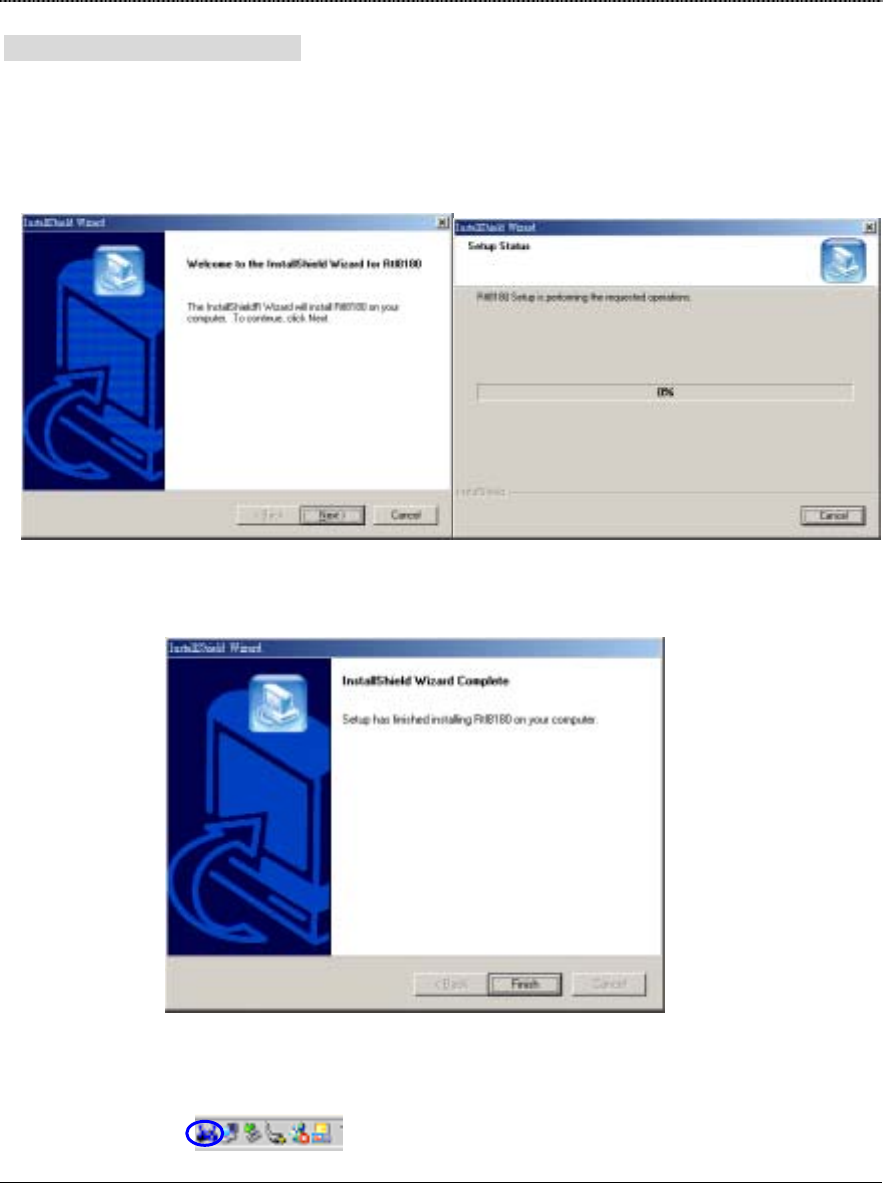Arcadyan Technology WN4403ARC 11g miniPCI card User Manual Wireless LAN PC Card
Arcadyan Technology Corporation 11g miniPCI card Wireless LAN PC Card
Users manual

WN4403 802.11g miniPCI Adapter
User’s Manual
1. Introduction
The WN4403 is designed to provide Wireless LAN finction on a MiniCPI Type IIIB form factor which is
for built-in Wireless gateway/Wireless ADSL Router. The function is based on Intersil ISL3686 chipset, which implements the full
IEEE802.11g standard data rates up to 54 Mbps.
2. Features
- TI TNETW1130GVF MAC and Basband Processor and Rasia RC2422B and RC2326 RF chip.
- IEEE802.11 Direct Sequence Spread Spetrum (DSSS) and Orthogonal Frequency Division Multiplexing (OFDM)
- IEEE802.11 Standard Data Rates: 1, 2, 5.5 and 11 Mbps and up to 54Mbps 11g.
- Full implementation of the MAC protocol specified in IEE Standard of 802.11-1999 and 802.11g.
- Internal encryption engine executes IEEE 802.11 WEP
- 128-bit WEP encryption, backward compatible with 64-bit solution
- Support BSS and IBSS operation under Distributed Coordination Function (DCF) and Ponit
Coordination Function (PCF)
- Support two antenna.
3. Specification
3.1 Interface:
- IEEE 802.11g compliant
- PCI Bus interface specification 2.2
- MiniPCI type A
3.2 Mechanical
Dimension: 42.45 x 59.75 x 4.8 mm (L x W x H)
4. Environmental Operating Ranges
- Operating Temperature : 0 ~55° C , Humidity 10 ~ 90%
- Storage Temperature : -20 ~90° C, Humidity 10 ~ 90%
5. Power Consumption
450 m A
9.Drivers support
Microsoft Windows 98SE, Windows ME/2000 /XP,

10.Drivers installation
*Windows 98SE/Me/2000/XP:
The following installation operates under Windows 2000. Procedures will be the same for Windows 98SE/Me/XP.
I. Install the Driver and Utility
A. Insert the CD into the CD-ROM device and execute the " setup.exe" program. The InstallShield Wizard box will appear, click
"Next" to continue.
B. Follow the instruction of the installation program. The program will install the software for this device directly.
C. Click "Finish" to complete the installation.
D. After completing the Driver adn Utility installation, a new icon will be displayed in the system tray at the bottom of the
screen. Click the icon and start using the WLAN MiniPCI Adapter.
Federal Communication Commission Interference Statement
This equipment has been tested and found to comply with the limits for
a Class B digital device, pursuant to Part 15 of the FCC Rules. These
limits are designed to provide reasonable protection against harmful
interference in a residential installation. This equipment generates,
uses and can radiate radio frequency energy and, if not installed and
used in accordance with the instructions, may cause harmful
interference to radio communications. However, there is no guarantee
that interference will not occur in a particular installation. If this
equipment does cause harmful interference to radio or television
reception, which can be determined by turning the equipment off and
on, the user is encouraged to try to correct the interference by one of
the following measures:
- Reorient or relocate the receiving antenna.
- Increase the separation between the equipment and receiver.
- Connect the equipment into an outlet on a circuit different from that
to which the receiver is connected.
- Consult the dealer or an experienced radio/TV technician for help.
This device complies with Part 15 of the FCC Rules. Operation is
subject to the following two conditions: (1) This device may not cause
harmful interference, and (2) this device must accept any interference
received, including interference that may cause undesired operation.
FCC Caution: Any changes or modifications not expressly approved by
the party responsible for compliance could void the user's authority to
operate this equipment.
IMPORTANT NOTE:
FCC Radiation Exposure Statement:
This equipment complies with FCC radiation exposure limits set forth for an
uncontrolled environment.
This transmitter must not be co-located or operating in conjunction with any
other antenna or transmitter.
This equipment should be installed and operated with minimum
distance 20cm between the radiator & your body.

This device is intended only for OEM integrators under the following
conditions:
1) The transmitter module may not be co-located with any other transmitter
or antenna.
As long as conduction above is met, further transmitter test will not be
required. However, the OEM integrator is still responsible for testing their
end-product for any additional compliance requirements required with this
module installed (for example, digital device emissions, PC peripheral
requirements, etc.).
IMPORTANT NOTE: In the event that these conditions can not be met (for
example certain laptop configurations or co-location with another transmitter),
then the FCC authorization is no longer considered valid and the FCC ID can
not be used on the final product. In these circumstances, the OEM integrator
will be responsible for re-evaluating the end product (including the transmitter)
and obtaining a separate FCC authorization.
End Product Labeling
The final end product must be labeled in a visible area with the following:
“Contains TX FCC ID: ”.
Manual Information That Must be Included
The OEM integrator has to be aware not to provide information to the end
user regarding how to install or remove this RF module in the users manual of
the end product which integrate this module.
The users manual for OEM integrators must include the following information in a
prominent location "IMPORTANT NOTE: To comply with FCC RF exposure
compliance requirements, the antenna used for this transmitter must be installed
to provide a separation distance of at least 20 cm from all persons and must not be
co-located or operating in conjunction with any other antenna or transmitter.
2)The antenna must be installed such that 20 cm is maintained between the antenna and users.